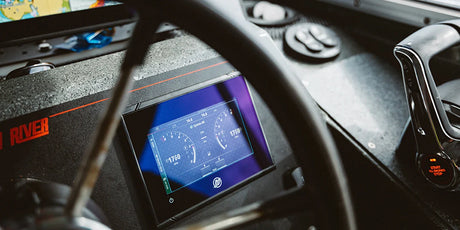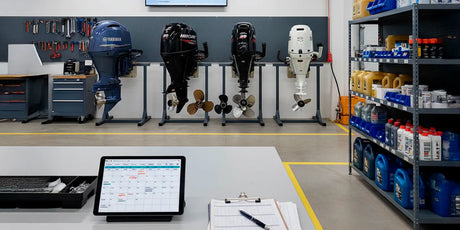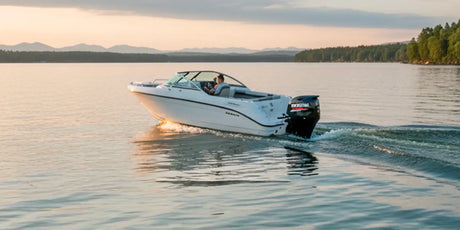Choosing the right marine fuel is crucial for engine performance and longevity. Whether you're wondering what fuel boats use, if boats take regular gas, or the best fuel for outboard motors, understanding fuel types can help prevent engine damage and improve efficiency. This guide will help you navigate boat motor types, fuel options, and the differences between marine gas and regular gas.
Using the right marine fuel for your boat’s engine is essential for reliable and optimal performance on the water.
Because different makes and models of boat engines require different fuels, using the wrong boat fuel can cause significant damage to internal engine components as well as your boat’s fuel system.
For many boat owners, it’s common to feel a bit unsure as to which type of marine fuel is right for their engine(s). Choosing between different ethanol levels, mixing oil with fuel, and even using diesel can be downright confusing.

In this article, we’ll cover what you need to know about choosing the right marine fuel for your boat’s engine. This includes:
- What Fuel Do Boats Use? Understanding Marine Fuels
- How to Choose the Right Marine Fuel for Your Motor
- How Does Bad Gas Affect Your Boat Motor?
- Is There a Difference Between Marine Gas and Regular Gas?
- Do Boats Take Regular Gas? Understanding Boat Fuel Types
- How Much Does Boat Gas Cost?
What Fuel Do Boats Use? Understanding Marine Fuels
Boats use different types of fuel depending on the engine type. Most modern outboards and sterndrive engines use ethanol-free gasoline (REC-90) or E10 fuel. Diesel is common for larger boats and yachts. Always check your owner's manual to determine the best fuel for your boat.
The following are the most common types of marine fuels for your boat:
- Ethanol-Free Gasoline
- Best for outboard motors, sterndrives, and smaller boats.
- Prevents fuel system corrosion and improves engine longevity.
- More expensive but recommended by most manufacturers.
- E10 Fuel (10% Ethanol Blend)
- Widely available and cheaper than ethanol-free gas.
- Safe for most modern outboards and sterndrives.
- Requires fuel stabilizers to prevent water contamination.
- E15 Fuel (15% Ethanol Blend)
- Not recommended for most boats due to water absorption issues.
- Illegal for marine use under federal regulations.
- Diesel Fuel
- Used in larger boats, yachts, and commercial vessels.
- More efficient than gasoline but higher initial cost.
- Longer engine lifespan with lower maintenance costs.
- Gas and Oil Mixtures (2-Stroke Engines)
- Found in older outboards and small engines.
- Requires correct gas-to-oil ratio (typically 50:1 or 100:1).
- Use only marine-grade oil to prevent excessive smoke and deposits.
- Marine Diesel Oil (MDO) & Marine Gas Oil (MGO)
- Used in commercial shipping and large yachts.
- Not available at most marinas and not suitable for standard boat engines.

A lot of fuel choices come down to your type of boat motor. Let’s go over the basic types of marine fuel you can find when filling up, their usages, and which ones to use.
What is marine gas fuel?
Marine Gasoil is composed of blends of distillates. Distillates are the evaporated components of crude oil during the distilling process, that are condensed from gas state to liquid state. Marine Gas may be compared to diesel, just that the density and storage requirements are different.
REC-90
Ethanol-free gasoline is produced in a few different octane levels. REC-90 is marketed for boaters and for use in other small engines. It’s an ethanol-free, 90-octane unleaded gasoline blend designed for use in marine and small engines that ethanol found in other gasoline blends can damage.
Ethanol-free gasoline does not come with the corrosive effects of gasoline containing ethanol. You can expect the best performance and lifespan of your boat’s engine from this type of boat gas.
Ethanol-free marine fuel does have a few downsides:
- Gasoline that is ethanol-free is more expensive than E10 or other types of gasoline.
- Ethanol-free fuel uses the octane enhancer additive methyl tert-butyl ether (MTBE) to produce a cleaner exhaust for the environment. However, if you combine MBTE with ethanol from other fuel types, a gummy residue may cause clogged fuel filters and performance issues. Because of this, it’s essential not to mix ethanol-free gasoline with other types of gasoline. If you want to switch gasoline types, it may require a thorough cleaning of all fuel tanks and lines to ensure optimal performance.
Ethanol-Free Gasoline
Although REC-90 is marketed to the marine industry and is commonly found at marinas, there are other octane levels of ethanol-free gasoline on the market such as ethanol-free 87 or 92 octane. While always refer to your owner’s manual, these other common octane levels are typically suitable for marine engines.
E10 Fuel
As one of the most widely-available and inexpensive marine fuels, E10 is safe for most boat engines. E10 stands for “10% ethanol content” gasoline. Ethanol was introduced to reduce hydrocarbon emission pollution without substantially affecting performance.
There are a couple of downsides of using E10 marine fuel:
- The solvent properties of ethanol can corrode rubber and fiberglass quickly. While ethanol is used to remove gum deposits, it can degrade fuel lines and other components, leading to clogged fuel lines.
- Ethanol attracts water into your fuel system through “phase separation,” inviting internal corrosion, erosion of fiberglass, and uneven performance on the water. Because of this, experts recommend draining E10 from your tank during storage or between ninety (90) days of usage.
- Older boat motors from a decade ago were designed before the introduction of E10, which means that there may be some performance issues inherent in the motor’s operating specifications.
Adding a high-quality fuel additive, like Star Tron Enzyme Fuel Treatment, to your tank with every fill-up goes a long way toward protecting your engine from any potentially damaging impact of ethanol.
E15 Fuel
E15 marine fuel is like E10 but contains 15% ethanol. Although it is significantly cheaper than E10, E15 is not recommended for most boat engines due to its increased risk of phase separation and internal corrosion.
While there is a significant push by legislators to make E15 more widely available for boaters (and other applications), emissions from E15 are bad for the environment, and it is prohibited by federal law for use in recreational boat engines.
Oil and Gas Mixtures
For some boat engines, such as smaller outboards and 2-stroke lower-horsepower models, boaters must add a mixture of oil to their gasoline. The purpose of this oil and gas mixture is to help lubricate the engine’s internal moving parts and run smoother than gas-only fuel.
Here are a couple of pointers for using oil and gas mixture fuels:
- Only mix oil into your fuel should only be performed on specified engines. Most larger, modern boat engines have their own lubrication system separate from the fuel system, eliminating the need for oil-gas mixtures.
- Oil and gas ratios will vary based on your particular model, so be sure to check your owner’s manual for exact mixing ratios. Common mixing ratios (gas:oil) include:
- 25:1 (typically during the break-in period)
- 50:1
- 100:1
To achieve these ratios, you’ll need to perform some basic math:
- For a 50:1 gas:oil ratio, you will need to use 2.6 fluid ounces of oil per gallon of gas added to your fuel tank.
- For 25:1, you will add 5.2 fluid ounces of oil to your fuel tank.
- Finally, for 100:1, the ratio is 1.3 fluid ounces of oil to your fuel tank.
- It’s essential to find the correct ratio of oil to fuel to prevent several bad outcomes. From smoking motors, hiccuping performance at high RPMs, and even significant internal damage, adding too much or too little oil can cause damage. For this reason, many boaters pre-mix their gasoline before filling up to avoid an imbalance.
- Only use marine oil that meets the TC-W standard for this mixture to get the best performance and longest life out of 2-stroke engines. Due to the higher RPMs and the proximity to water sources, marine oil – particularly marine oil from the original engine manufacturers – deals better with the demands of the marine environment.
Diesel Fuel
Diesel outboard engines are relatively rare, but there are a number of inboard motors that run off diesel. Because diesel engines offer more torque and horsepower, only larger vessels typically use diesel.
While diesel is more expensive per gallon, it is also up to 10% more efficient. By going further on less, it may be cheaper overall to use diesel fuel. Also, diesel engines have a longer lifespan, resulting in additional cost savings.
Marine Gas Oil (MGO) and Marine Diesel Oil (MDO)
Most recreational boaters won’t come across two common types of fuel used in large commercial vessels: marine gas oil (MGO) and marine diesel oil (MDO).
These marine fuels are considered distillate fuels, used primarily in medium- and high-powered ships, and are usually not available at most marinas. However, it’s important to be aware of this fuel and not use it in ordinary diesel motors unless otherwise specified.

How to Choose the Right Marine Fuel for Your Motor
Consult the Owner’s Manual
First and foremost, your engine’s owner manual has guidance on fuel and oil requirements. Look under ”engine specifications” for which type of boat fuel is best for your engines. Many owner’s manuals are available online, or you can order a copy from an authorized dealer.
Following the fuel and oil specifications in the owner’s manual also helps ensure that you comply with the manufacturer’s warranty requirements. Failure to fill up with the proper fuel may void the warranty and leave you on the hook for expensive repairs that would otherwise be covered.
Modern Engines vs. Older Models
All current outboard, sterndrive, and inboard gasoline engines operate safely on marine fuel with no more than 10% ethanol content.
Older engines, however, were designed and manufactured before any amount of ethanol was added in boating, so expect ethanol-free gasoline or diesel to be the only options according to original specifications.
Size of Your Boat
Depending on the size of your boat and the required horsepower, your fuel needs will be based on your engine.
- Smaller boats typically require gasoline or gas and oil mixtures (such as trolling motors).
- Medium-sized boats that range from 30′ to 40′ tend to require gasoline, a gasoline and oil mixture, or diesel.
- Larger commercial boats exceeding 40′ will almost always come with diesel engines.
How Does Bad Gas Affect Your Boat Motor?
Using the wrong type of gas or simply marine fuel that’s been left in your engine’s fuel system too long can lead to severe issues with your boat engines.
The following are the most common issues from bad or mismatched gas include:
- Internal corrosion
- Seized internal components
- Poor combustion
- Clogged fuel lines, fuel injectors, and fuel filters
- Fuel leaks
- Water infiltration
- Engine bogs
- Reduced RPMs
- Uneven idle
- Stalling
- Smoking motor components
- Excessive heat
- And more
How to Identify and Fix Bad Gas in a Boat Engine?
Bad gas in a boat can lead to performance issues, stalling, and engine damage if left unchecked. Here’s how to recognize and fix bad fuel before it causes serious problems.
Signs of Bad Gas in a Boat:
- Engine Hesitation or Stalling – If your boat idles roughly, hesitates, or struggles to accelerate, old or contaminated fuel may be the culprit.
- Loss of Power – A noticeable drop in speed or power at high RPMs can indicate water contamination in the fuel.
- Unusual Engine Sounds – Knocking, pinging, or misfires can occur due to poor fuel combustion from degraded gas.
- Dark or Cloudy Fuel – Healthy fuel is clear and light amber. If your gas appears dark, cloudy, or has visible debris, it’s likely contaminated.
- Strong Odor or Gum Deposits – Ethanol-blended fuels can oxidize and form gummy residues, clogging injectors and carburetors.
How to Fix Bad Gas in Your Boat's Fuel System?
If you suspect your boat’s fuel has gone bad, follow these steps:
1. Drain and Replace the Bad Fuel
- Siphon or pump out the old gas into an approved fuel container.
- If your boat has a fuel-water separator, drain any collected water.
- Dispose of old fuel properly according to local regulations.
2. Clean the Fuel System
- Inspect and replace clogged fuel filters to prevent debris from reaching the engine.
- Use a fuel system cleaner to dissolve deposits in the injectors and carburetor.
- Check fuel lines for cracks or leaks that might have allowed contaminants to enter.
3. Use a High-Quality Fuel Additive
- Adding a marine fuel stabilizer helps prevent ethanol phase separation and extends gas life.
- Star Tron Enzyme Fuel Treatment or Sta-Bil Marine are great options to protect against bad gas.
4. Prevent Future Fuel Issues
- Use ethanol-free gas (REC-90) whenever possible to reduce moisture absorption.
- If using E10 fuel, always add a marine fuel stabilizer.
- Store fuel properly – never leave gas sitting for more than 90 days without treatment.
Is There a Difference Between Marine Gas and Regular Gas?
As a general rule, avoid marine fuel with ethanol or high-ethanol content (anything above 10% ethanol) whenever possible.
Ethanol attracts water and moisture from the air through the fuel tank vent system. This happens due to a process called “phase separation.” When this moisture accumulates at the bottom of the fuel tank or throughout the fuel system, the engine’s performance is dramatically reduced, corrosion forms through oxidizing internal components, and dilutes the gasoline.
To prevent phase separation, boaters have a few methods:
- Install a 10-micron water-separating fuel filter between the fuel tank and the boat engine to keep water and other contaminants out.
- Use a fuel stabilizer in every tank of fuel, either when storing the boat long-term or between fill-ups.
Do Boats Take Regular Gas? Understanding Boat Fuel Types
The answer to this question is both yes and no:
- Yes, you can use the same gasoline as a car in your boat engines; however, this fuel must be E10 or ethanol-free gasoline. E15 or gasoline with higher levels of ethanol is not recommended.
- Marine fuel for smaller outboard or 2-stroke outboard engines often requires a gasoline and oil mixture, which requires knowing the right ratios.
Above all, make sure that you pay attention to what is available at the pump. Using the wrong gasoline – even in a pinch – can lead to serious damage and performance issues, all of which can be avoided by using appropriate fuel. Last, if you don’t trust a gas station’s gas or it’s not clearly labeled, avoid using it at all.
How Much Does Boat Gas Cost?
- The price of marine fuel varies based on location, ethanol content, and octane level.
- Ethanol-free gas (REC-90) is more expensive, costing $1.00–$2.00 more per gallon than regular gas.
- Diesel fuel is cheaper per gallon, but diesel engines are more expensive upfront.
- At a marina, expect to pay $4.00–$6.50 per gallon, whereas gas stations may be cheaper.
- Using fuel stabilizers can extend fuel life and reduce costs over time.
Now that you know the answer to “What kind of gas should I use in my boat?” you can make more informed decisions for your boat’s engine to enjoy the best performance and longevity on the water.
PartsVu carries a wide assortment of fuel additives and fuel system components to help your engine run reliably and at peak performance for years to come.
Born Again Boating created and produced the embedded video. Subscribe to Born Again Boating’s YouTube channel by clicking here.













2 comments
thank you much, I ride a motorcycle from the ’80’S and due to short riding seasons it get stored 6 months . I also had an issue with mixing e10 w/ ethanol free, a lot of problems . after reading your help feature, I won’t be doing that again, ever.
———
PartsVu replied:
You’re very welcome! Storing a motorcycle for six months and dealing with fuel mixtures can definitely lead to some unexpected issues. Glad to hear our help feature provided useful information! Sticking with one type of fuel and using proper storage techniques should make a big difference in keeping your bike running smoothly. Ride safe, and if you ever need more tips or assistance, feel free to reach out! Best, Markine
I every timе еmailеd this blog p᧐st page to all my friends, because if like
to read іt next my contacts ᴡill too.